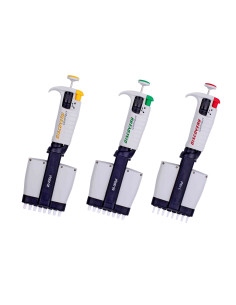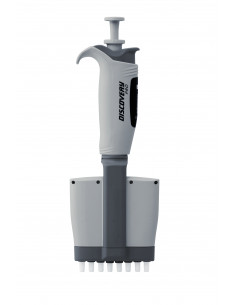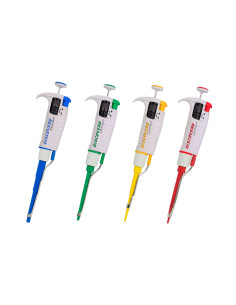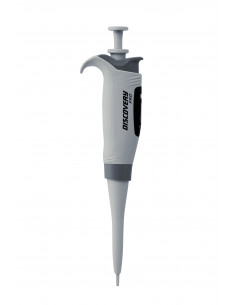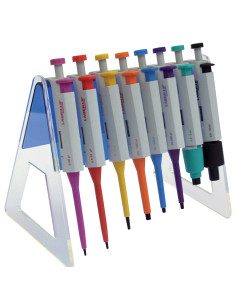Micropipettes are essential instruments in modern laboratories, allowing the precise handling of very small liquid volumes, typically in the microliter (µL) range. Their precision and accuracy are crucial to ensuring the reliability of experimental results in various scientific disciplines.
What Is a Micropipette and How Does It Work?
A micropipette is a laboratory device designed to aspirate and dispense specific volumes of liquids with high precision. It consists of a main body housing a spring-actuated piston and a disposable plastic tip where the liquid is held. The volume to be aspirated is adjusted using a dial at the top of the micropipette, allowing the user to select the exact amount of liquid needed.
The basic operation involves pressing the plunger to the first stop, immersing the tip in the liquid, releasing the plunger to aspirate the desired volume, and then dispensing the liquid into the target container by pressing the plunger again. This mechanism ensures precise volume handling, reducing the margin of error in experimental procedures.
Main Uses of Micropipettes in Laboratories
Micropipettes are versatile tools used in a wide range of laboratory applications:
Micropipettes in Scientific Research Laboratories
In chemical and biological research, micropipettes are indispensable for solution preparation, reagent mixing, and conducting experiments that require precise handling of minimal volumes. For example, in molecular biology studies, they are used to pipette DNA, RNA, and protein samples, ensuring accuracy in concentrations and volumes.
Micropipettes in Clinical and Medical Laboratories
In clinical settings, micropipettes are used for blood analysis, diagnostic tests, and biotechnology procedures. They enable precise handling of biological samples, which is crucial for obtaining reliable and reproducible diagnostic results.
Micropipettes in the Pharmaceutical Industry
In drug formulation and quality control, micropipettes are used to measure and transfer small amounts of chemical compounds, ensuring the consistency and efficacy of pharmaceutical products. Their precision is vital for meeting regulatory standards and ensuring medication safety.
Micropipettes in Microbiology and Biotechnology Laboratories
In these fields, micropipettes are essential for handling cell cultures, performing genetic analyses, and techniques such as polymerase chain reaction (PCR). The ability to accurately measure and transfer small volumes is fundamental to the success of these procedures.
What Types of Micropipettes Exist, and How to Choose the Right One?
There are various types of micropipettes, each tailored to specific needs:
- Fixed-volume micropipettes: Designed to dispense a specific and constant volume, ideal for repetitive procedures requiring the same liquid amount in each dispensing.
- Variable-volume micropipettes: Allow the user to adjust the dispensed volume within a specific range, offering flexibility for different applications. They are widely used in laboratories handling various techniques and protocols.
- Single-channel micropipettes: Have a single tip and are used for individual liquid transfers. They are common in most laboratory procedures.
- Multichannel micropipettes: Equipped with multiple tips (usually 8 or 12), they allow dispensing liquids into several samples simultaneously, increasing efficiency in processes such as assay plate preparation.
The choice of the appropriate micropipette depends on the sample type, the required volume, and the nature of the experiment. It is important to consider factors such as precision, ergonomics, and compatibility with available pipette tips in the laboratory.
Factors to Consider for Proper Micropipette Use
To ensure optimal micropipette performance, the following aspects should be considered:
- Precision: Ensure that the micropipette is correctly calibrated to dispense the exact required volume.
- Calibration: Perform periodic calibrations according to the manufacturer’s recommendations and laboratory regulations to maintain measurement accuracy.
- Maintenance: Conduct regular and proper cleaning of the micropipette, including lubrication of internal parts if necessary, to extend its lifespan and ensure proper functionality.
- Use of appropriate tips: Use compatible, high-quality tips to prevent leaks or errors in liquid dispensing.
- Pipetting technique: Follow recommended practices, such as smoothly aspirating and dispensing the liquid and keeping the micropipette in an upright position during pipetting to avoid inaccuracies.
Find the Ideal Micropipette at Pobel
If you are looking for a high-precision micropipette for your laboratory, Pobel offers a wide selection of models tailored to various applications. Our team of experts can guide you in choosing the ideal micropipette based on your needs. Explore our catalog and enhance your laboratory’s precision with the best micropipettes on the market.
Frequently Asked Questions
What is the difference between a fixed-volume and a variable-volume micropipette?
Fixed-volume micropipettes always dispense the same amount of liquid, whereas variable-volume micropipettes allow users to adjust the volume as needed for different procedures.
How should a micropipette be used correctly?
For proper use, it is essential to select the appropriate volume, use compatible tips, aspirate the liquid smoothly, and dispense it precisely without generating air bubbles.
What precautions should be taken when using micropipettes in the laboratory?
It is recommended to calibrate them periodically, handle them carefully, avoid contact with corrosive liquids, and ensure that the tips are properly attached before pipetting.



